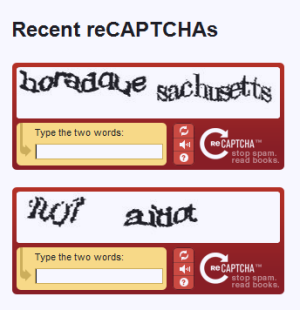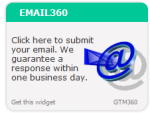It wasn’t very long ago that I’d extolled the virtues of reCAPTCHAs and had introduced them in this blog to make it easy for people to leave behind comments without my getting hit by tons of spam. For the uninitiated, reCAPTCHAs originated from CAPTCHA, or Completely Automated Public Turing Test To Tell Computers and Humans Apart, and use graphical images that readers have to decipher in order to prove that they’re human – and not a computerized bot – before submitting forms and comments on websites and blogs.
 However, I’ve recently been finding reCAPTCHAs to be quite complex. Fearing that they’d confuse readers wishing to leave comments, I recently replaced them with Disqus, a simpler yet more powerful blog commenting platform that does an equally good job at keeping me protected from spam.
However, I’ve recently been finding reCAPTCHAs to be quite complex. Fearing that they’d confuse readers wishing to leave comments, I recently replaced them with Disqus, a simpler yet more powerful blog commenting platform that does an equally good job at keeping me protected from spam.
It looks like I’m not alone.
According to a recent study reported in the New York Times, reCAPTCHAs are so confusing that about 25% of users simply fail in their attempts to solve them. For businesses that use reCAPTCHAs before permitting their website visitors to download white papers, register for webinars, and otherwise respond to their calls to action (CTAs), this results in a significant loss of prospective customers who are driven away by the complexity of reCAPTCHA. Lest you think that the 25% figure is exaggerated, just have a look at a couple of reCAPTCHAs that I came across recently, and you might start wondering how the remaining 75% do manage to crack them!
At the same time, reCAPTCHAs have proved to be very effective in keeping out spam since they can’t be cracked by computerized bots which are the source of most spam.
Does this mean that website abandonment caused by the complexity of reCAPTCHAs is to be considered a cost of doing business? Obviously not, since turning off prospects can never be an option for any business.
If that be the case, are there any alternatives by which marketers and website owners can make it easy for their website visitors to leave behind their comments and contact details, yet insulate themselves from spam? Yes, there are at least two other solutions I can think of to this end.
 One is to continue to use graphical images but make them far simpler for humans to crack them. The graphical codes used by the leading online book rental Librarywala.com present a good example. Although I’m not aware of the underlying technology used in this case, I’m sure that it’s as effective as reCAPTCHA in keeping out spam.
One is to continue to use graphical images but make them far simpler for humans to crack them. The graphical codes used by the leading online book rental Librarywala.com present a good example. Although I’m not aware of the underlying technology used in this case, I’m sure that it’s as effective as reCAPTCHA in keeping out spam.
 The other solution is to avoid images altogether and instead use AJAX-powered hosted forms that not only keep away spam but also collect contacts of their website visitors. The GTM360 website provides an example of this approach. By providing fluid in-page transitions, minimizing the number of keystrokes, and avoiding confusing CAPTCHA codes, this technology delivers a superior customer experience and persuades more website visitors to respond to CTAs. At the same time, by incorporating powerful validation and gatekeeping logic, it prevents computerized bots from dumping spam.
The other solution is to avoid images altogether and instead use AJAX-powered hosted forms that not only keep away spam but also collect contacts of their website visitors. The GTM360 website provides an example of this approach. By providing fluid in-page transitions, minimizing the number of keystrokes, and avoiding confusing CAPTCHA codes, this technology delivers a superior customer experience and persuades more website visitors to respond to CTAs. At the same time, by incorporating powerful validation and gatekeeping logic, it prevents computerized bots from dumping spam.
![]() Although it’s a bit difficult and expensive for website owners to develop this functionality on their own, our EMAIL360 application provides a ready-made solution by using advanced widget technology. Marketers and website owners keen on transforming their websites into lead generation engines simply need to visit the EMAIL360 website to enter a few basic details, and collect the widget code for publishing on their own websites. Voilà, their websites will immediately have this functionality! This process takes no more than a couple of minutes and doesn’t call for any IT support. EMAIL360 is best suited for web pages that contain newsletter signup, trial version download, webinar registrations, whitepaper downloads and other forms of CTAs (calls to action).
Although it’s a bit difficult and expensive for website owners to develop this functionality on their own, our EMAIL360 application provides a ready-made solution by using advanced widget technology. Marketers and website owners keen on transforming their websites into lead generation engines simply need to visit the EMAIL360 website to enter a few basic details, and collect the widget code for publishing on their own websites. Voilà, their websites will immediately have this functionality! This process takes no more than a couple of minutes and doesn’t call for any IT support. EMAIL360 is best suited for web pages that contain newsletter signup, trial version download, webinar registrations, whitepaper downloads and other forms of CTAs (calls to action).
I’m sure there are other alternatives to reCAPTCHAs and I encourage readers to share their knowledge on them via comments to this post.
Pingback: Season’s Greetings! « Talk of Many Things
Pingback: If You Must Use A Long Form, At Least Pre-Fill As Much Of It As You Can « Talk of Many Things